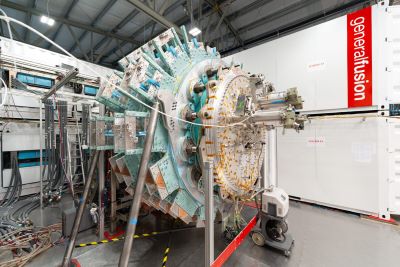Fusion energy attracting more investment, achieving technical milestones on path to commercialization
Mark LoweyApril 16, 2025
 Fusion energy development is attracting more investment, achieving many technical milestones and getting closer to a commercial-scale affordable, clean power source, say analysts and industry representatives.
Fusion energy development is attracting more investment, achieving many technical milestones and getting closer to a commercial-scale affordable, clean power source, say analysts and industry representatives.
 “There’s a lot of excitement and a lot of movement forward,” Andrew Holland (photo at left), CEO of the Washington, D.C.-based Fusion Industry Association, said during a webinar by the Cleantech Group.
“There’s a lot of excitement and a lot of movement forward,” Andrew Holland (photo at left), CEO of the Washington, D.C.-based Fusion Industry Association, said during a webinar by the Cleantech Group.
There’s a bad joke that “fusion is 30 years away and always will be,” he said. “The truth is that a lot has happened over those 30 years.”
“Fusion really is a global energy industry where there are a lot of things moving and a lot of stuff happening,” Holland said.
The 42 member-companies in the Fusion Industry Association have collectively raised more than $8 billion in investment and are regularly achieving technical milestones, he said.
“When scientists say they’re going to build the next machine, they’re confident that next machine will be a break-even machine,” Holland said. In other words, the fusion machine will produce as much energy as the energy required to operate it.
Fusion companies are building and testing a wide variety of fusion machines, he said. “The next machines will prove out that they get to this break-even fusion in a commercially relevant manner.”
Industry surveys show fusion energy developers expect to see fusion-generated electricity on grids by the early 2030s, with economically viable fusion electricity by the late 2030s, Holland noted.
 “It’s really an enormous growth [in fusion energy R&D] we’ve seen in recent years,” said Anthony DeOrsey (photo at right), research manager at the Cleantech Group, based in San Francisco.
“It’s really an enormous growth [in fusion energy R&D] we’ve seen in recent years,” said Anthony DeOrsey (photo at right), research manager at the Cleantech Group, based in San Francisco.
 Zainab Gilani (photo at left), associate, energy and power at the Cleantech Group, said the fusion energy companies she talks to say they could potentially achieve consistent break-even energy within five years, and then proceed to scale up and commercialization.
Zainab Gilani (photo at left), associate, energy and power at the Cleantech Group, said the fusion energy companies she talks to say they could potentially achieve consistent break-even energy within five years, and then proceed to scale up and commercialization.
Nuclear fission – the technology used in large conventional nuclear power reactors – is the splitting of a heavy atom’s nucleus into lighter ones.
Nuclear fusion is the joining of two light atoms’ nuclei to form a heavier one. Both fission and fusion release energy; fusion is the process that powers the Sun and the stars.
Compared with nuclear fission, fusion produces much less radioactive waste (and only at low levels of radioactivity) and the process is inherently safer than fission, Gilani said.
The key to deploying fusion energy, whatever fusion technology is used, is “you have to produce enough energy and you have to do it in an economic manner,” Holland said.
“Fusion isn’t cheap. It’s at the very cutting edge of science. [Developing] fusion is hard and needs a lot of money,” he said.
The advantage of private sector fusion development is that companies with sufficient investment can go much faster than publicly funded fusion programs at research institutions and national laboratories, he added. As fusion energy development accelerates, there will be more public-private partnerships, Holland predicted.
The German government is ramping up support for fusion development companies to build pilot plants in both laser-based and magnetic confinement-based technologies. Last month, U.S.-German fusion startup Focused Energy signed a memorandum of understanding with energy utility RWE and the state of Hesse to develop a one-gigawatt fusion power plant at the former Biblis nuclear fission site in Germany.
The U.K. government in January announced a record £410 million investment in fusion energy over 2025 and 2026 as part of the government’s Plan for Change which is targeting economic growth. The funding will be used to build a prototype fusion power plant in Nottinghamshire.
At the same time, the government’s UK Industrial Fusion Solutions Ltd. unveiled the shortlisted organizations competing to become engineering partners and construction partners for STEP (Spherical Tokamak for Energy Production). A tokamak is a type of fusion machine.
Also in January, the U.S. Department of Energy (DOE) announced $107 million for six projects in the Fusion Innovative Research Engine Collaboratives, and that several privately funded fusion companies have completed early critical-path science and technology milestones in the Milestone-Based Fusion Development Program.
Both programs, administered by DOE’s Fusion Energy Sciences program in the Office of Science, are cornerstones of DOE’s fusion energy strategy to accelerate the viability of commercial fusion energy.
The Chinese government is investing an estimated $1 billion to $1.5 billion annually into fusion, and is building a new $570-million fusion research park in eastern China, on track to be completed this year, according to DOE.
Multiple fusion milestones being achieved
In terms of milestones, the U.S. Lawrence Livermore National Laboratory’s National Ignition Facility in December 2022 conducted the first controlled fusion experiment in history and achieved fusion ignition, known as “scientific breakeven.”
The facility’s experiment produced 3.15 megajoules of energy from a 2.05-megajoule input of laser light – for an energy gain of about 1.5 megajoules. However, this was only true with respect to the energy delivered by the laser. Reports sometimes omitted the approximately 400 megajoules of power input required to power the facility.
Nevertheless, Holland called the milestone fusion’s “Wright brothers’ moment,” comparing the achievement to when the Wright brothers' first successful airplane, the Wright Flyer, first achieved flight in December 1903.
In 2023, China’s Experimental Advanced Superconducting Tokamak (a fusion machine that creates a plasma) achieved sustained plasma at 70 million degrees Celsius – the temperature of the core of the Sun – for over 17 minutes.
In another milestone last month, Canada’s fusion energy developer – General Fusion in Richmond, B.C. – successfully formed a magnetized plasma in its LM26 machine’s target chamber.
The next step is to compress the plasma with a lithium liner to create fusion and heat from compression.
LM26 is designed to achieve a series of milestones required for commercial fusion: 10 million degrees Celsius, 100 million degrees Celsius, and scientific breakeven equivalent in a commercially relevant way.
The federal Strategic Innovation Fund has since 2019 invested $69 million in General Fusion, which has raised a total of $440 million to date. The company said since 2019 it has returned $3 to the Canadian economy through global private investment for every public dollar invested.
In another milestone, albeit a collaborative rather than scientific one, Everett, Washington-based fusion energy developer Helion Energy in 2023 announced an agreement to provide Microsoft with electricity from Helion’s planned first fusion power plant.
The plant is expected to be operational by 2028 and will target power generation of 50 megawatts or greater after a one-year ramp-up period. Helion, which has previously built six working prototypes, was the first private fusion company to reach 100-million-degree plasma temperatures with its sixth fusion prototype.
Helion in January announced raising US$425 million in a Series F round that will be used to scale commercialization efforts for the company’s fusion technology. The funding round brings the total invested in Helion to more than $1 billion and values the company at more than $5.4 billion.
Holland pointed out that fusion development is already yielding benefits even as it advances toward producing commercial-scale, affordable electricity.
For example, fusion energy developer TAE Technologies has spun off two subsidiaries based on its fusion technologies.
One company, TAE Power Solutions, aims to deliver a first-of-its-kind technology to improve the reliability, efficiency, longevity and affordability of electric-powered products, from vehicles to renewable energy storage.
The other company, TAE Life Sciences, leverages TAE’s proprietary accelerator technology for clinical investigation of a promising, previously inaccessible cancer treatment.
Fusion “is delivering benefits today, even before we get into the energy space. Fusion is unlocking this next-generation technology revolution,” Holland noted.
Fusion has regulatory and fuel advantages compared with nuclear fission
Holland said another big advantage of fusion compared with fission is that fusion will be regulated in the U.S. under the byproduct material regime, the same framework used to regulate technologies like medical isotopes and particle accelerators, rather than under the utilization facility regime used for nuclear fission reactors.
The U.S. is using this regulatory approach for fusion because it doesn’t present the same risks as fission, including the production of nuclear materials, such as plutonium-239 and uranium-235, that could be used for nuclear weapons.
This means fusion energy developers require only one licence to operate their machines, rather than the separate construction and operation licences required by nuclear fission reactor developers, including those planning small modular reactors. With one operation licence, fusion developers can build their machines and test their technologies.
In contrast, Portland, Oregon-based nuclear fission developer NuScale Power, for example, spent $500 million just meeting regulatory requirements for its proposed small modular nuclear reactor.
Fusion “will not face the same [regulatory] challenges that our cousins in fission face,” Holland said.
Fusion energy’s ultimate challenge is to be able to produce sustainable, affordable electricity, he said. The cost of fusion-generated electricity compared with that produced by conventional, renewable and fission nuclear power will be key.
“It doesn’t do you any good to make a fusion power plant if nobody wants to buy it,” Holland said.
Fusion’s cost advantage is its fuel, typically “light” isotopes of deuterium (widely available in seawater) and tritium (which can be generated onsite from the fusion reaction itself). Canada is a producer of tritium and has world-leading expertise in tritium handling, recycling and storage – essential for the fuel cycle of fusion power plants.
Holland said that unlike the complex process of constructing nuclear fission reactors, building commercial fusion power facilities will be more akin to an aircraft assembly line. There’s fundamentally no reason why fusion power can’t be cost-competitive with other sources of electricity and may end up being cheaper, he said.
The global fusion market is projected to reach about $843.6 billion by 2040, according to a report by Precedence Research.
A boom in power-hungry AI systems is rekindling interest in fusion technology, with investments last year more than tripling over the past year, to almost $3 billion, according to the Cleantech Group. Publicly disclosed funding for nuclear energy technologies hit a five-year high, exceeding a 2021 peak.
“Unique and complex reactor systems that previously would have been too difficult or uneconomical to pursue are seeing growing interest due to the advances in computing, 3D printing, precision manufacturing, advanced control systems, and higher-powered magnets,” Gilani said.
“While many of these emerging technologies still have critical milestones they need to achieve to prove out their concepts, their claims of attaining faster speeds-to-scale or better plasma stability are attracting the attention of investors interested in funding multiple pathways to commercialize fusion,” she said.
Holland agreed, saying: “Within our members, the excitement [and] the interest is driven by results. These companies are raising money based on things that they have done.”
See also: Canada needs a federally led national strategy to develop nuclear fusion: industry report
R$
Events For Leaders in
Science, Tech, Innovation, and Policy
Discuss and learn from those in the know at our virtual and in-person events.
See Upcoming Events
You have 1 free article remaining.
Don't miss out - start your free trial today.
Start your FREE trial Already a member? Log in
By using this website, you agree to our use of cookies. We use cookies to provide you with a great experience and to help our website run effectively in accordance with our Privacy Policy and Terms of Service.




